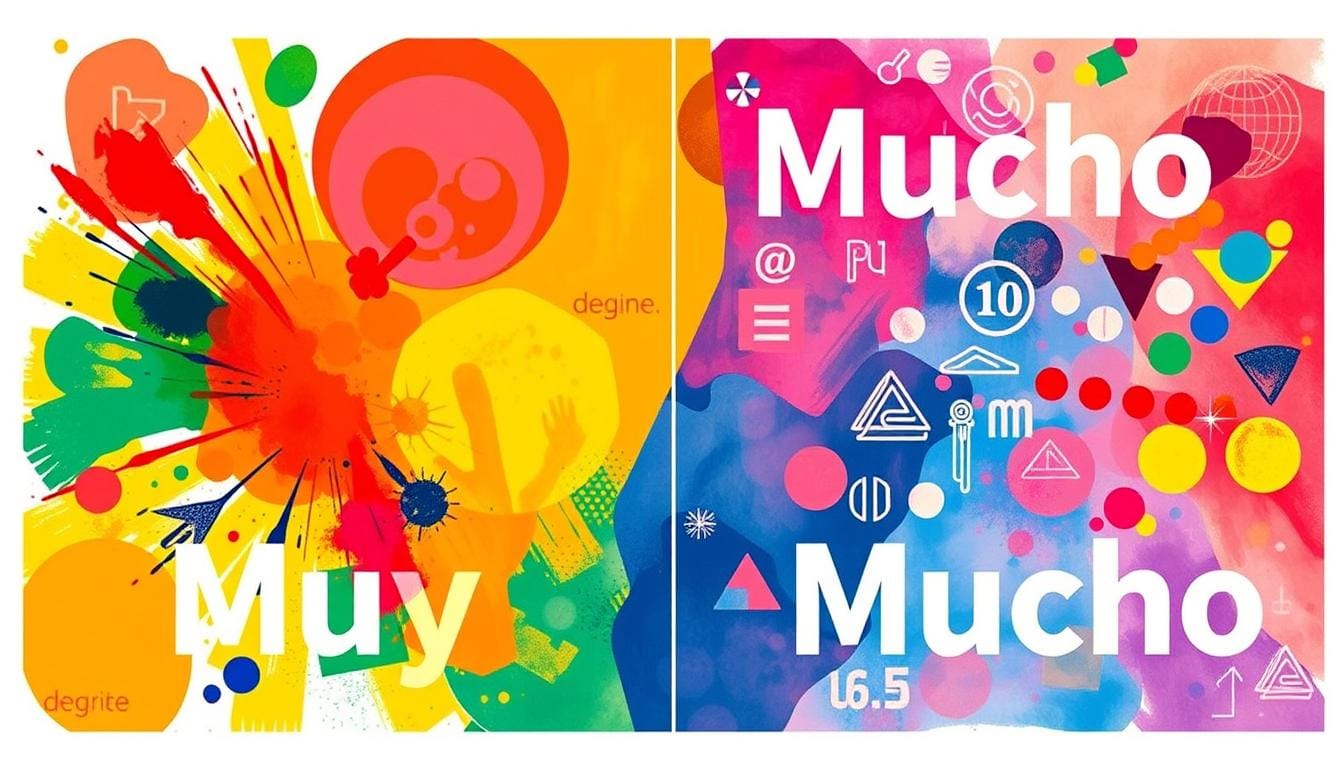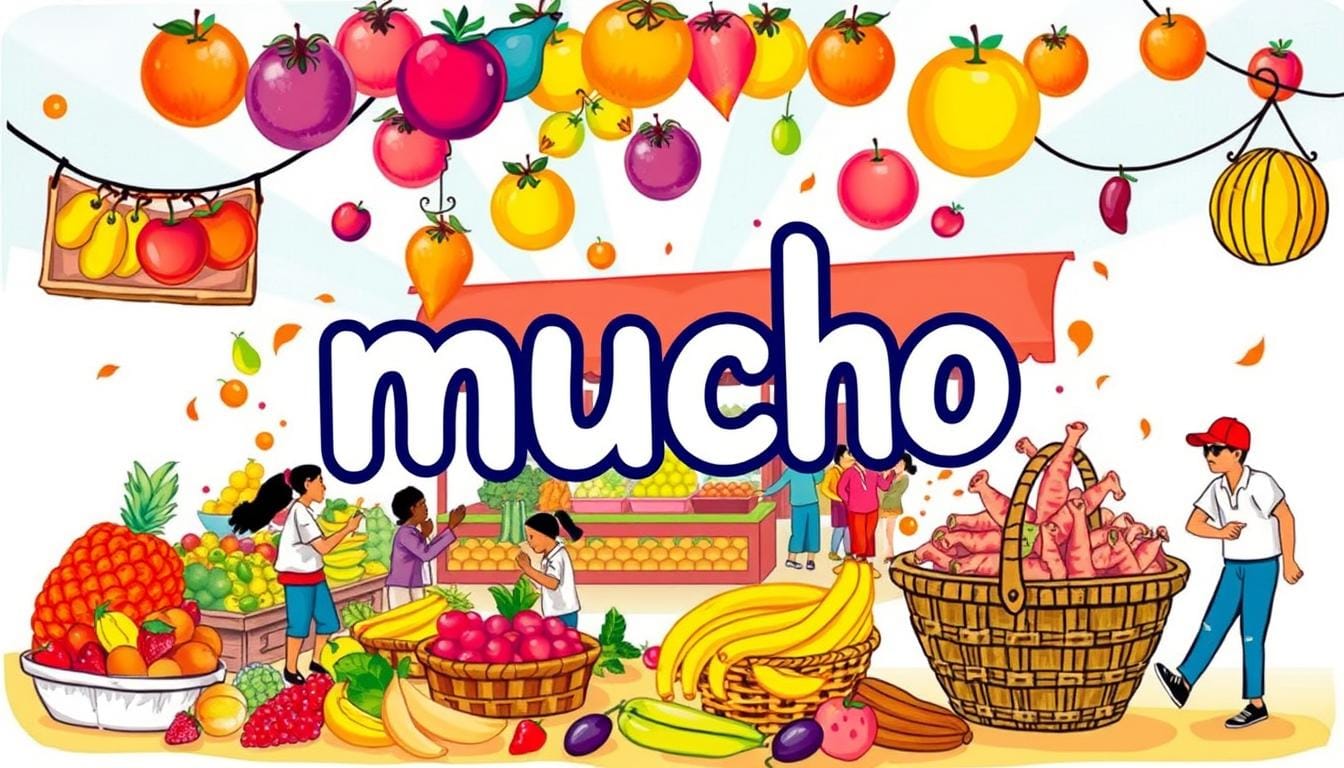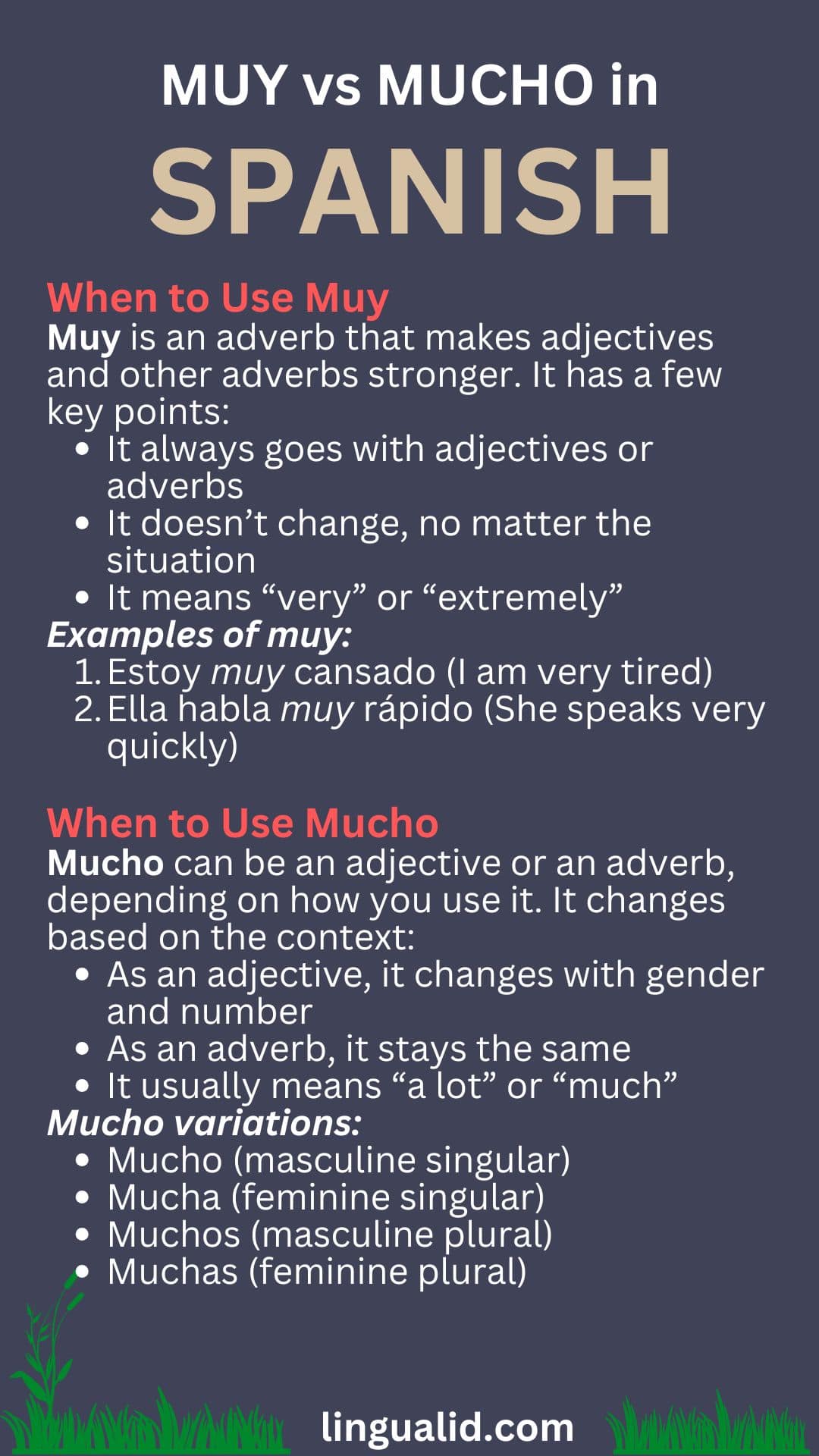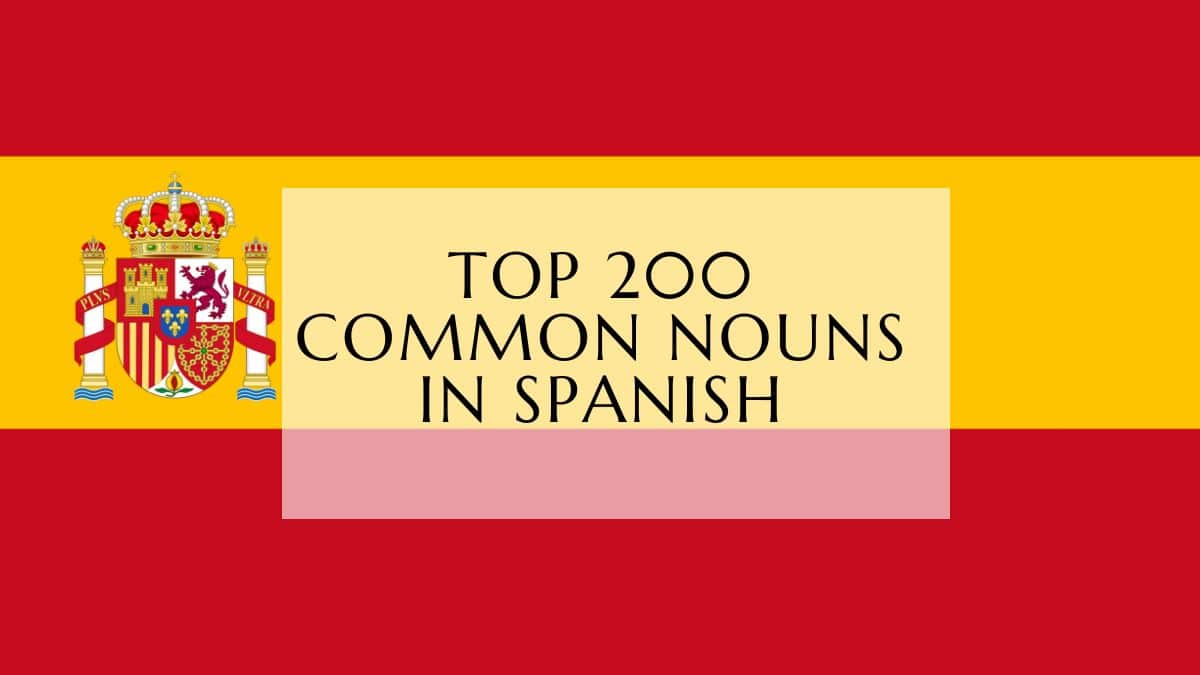Learning Spanish can be tough, especially when you get confused between muy and mucho. These words often cause trouble for Spanish learners. It’s important to know the difference between muy and mucho to get better at Spanish grammar.
Muy and mucho might sound alike, but they are used differently. Muy is always an adverb, meaning “very” or “quite”. On the other hand, mucho can be an adjective or an adverb. This makes mucho a bit trickier to use correctly.
Mastering these Spanish grammar rules will make you speak more clearly and naturally. Knowing when to use muy and mucho can take your Spanish skills from beginner to advanced.

Key Takeaways
- Muy is always an adverb meaning “very” or “quite”
- Mucho has multiple forms based on gender and number
- Muy does not change its form in different contexts
- Mucho can function as an adjective or adverb
- Context determines the correct usage of muy and mucho
- Key Takeaways
- Understanding Parts of Speech
- The Role of Gender and Number Agreement
- Key Differences in Usage
- When to Use Muy
- When to Use Mucho
- Common Mistakes to Avoid
- Gender Agreement Rules
- Number Agreement Rules
- Position in Sentences
- Everyday Phrases with Muy
- Formal Usage Expressions
- Latin American Usage Patterns
- Spanish Usage Considerations
- Conversational Contexts
- Written Communication Examples
- What's the main difference between muy and mucho in Spanish?
- How do I know when to use muy versus mucho?
- Does muy change based on gender or number?
- How does mucho change when used as an adjective?
- Can muy and mucho be used interchangeably?
- Are there regional differences in using muy and mucho?
- What's a common mistake Spanish learners make with muy and mucho?
- How do I use muy and mucho in emotional expressions?
- Can mucho be used as an adverb without changing its form?
- Are there any exceptions to the rules of muy and mucho?
Basic Grammar Rules: Muy and Mucho Explained
Learning Spanish means diving into the world of quantifiers and adverbs vs adjectives. Words like muy and mucho are key. They help us show how intense or many something is.
It’s important for Spanish learners to know the difference between muy and mucho. They might look similar, but they’re used in different ways.
Understanding Parts of Speech
In Spanish, muy and mucho work differently:
- Muy: Always acts as an adverb
- Mucho: Can be an adjective or an adverb
The Role of Gender and Number Agreement
Using these words right depends on agreement:
| Word | Forms | Usage |
|---|---|---|
| Muy | 1 invariable form | Modifies adjectives/adverbs |
| Mucho | 4 forms (mucho, mucha, muchos, muchas) | Agrees with noun gender/number |
Key Differences in Usage
Here are some examples to show the difference:
- Muy alto (very tall) – uses muy as an adverb
- Tengo muchos libros (I have many books) – uses mucho as an adjective
“Language learning is about understanding subtle grammatical nuances.” – Oualid Cheddadi
Getting good at using muy and mucho takes practice. You need to understand their special roles in Spanish.
The Core Functions of Muy in Spanish
In Spanish, “muy” is a key word that adds depth to our language. It’s an adverb that helps us emphasize qualities and traits. This makes our communication more precise and powerful.
The main job of muy is to change how we see adjectives and adverbs. It means “very” in English. What’s special about muy is that it doesn’t change form. This makes it easy to use in many different situations.
“Muy” allows speakers to add depth and nuance to their descriptions with remarkable ease.
- Modifies adjectives: El perro es muy grande (The dog is very big)
- Describes adverbs: Él canta muy bien (He sings very well)
- Intensifies expressions: La comida está muy rica (The food is very delicious)
When we dive into the Spanish language, knowing muy is key. It turns simple statements into richer, more detailed ones. It highlights specific qualities or the extent of an action.
Let’s look at some real-life examples:
- Travel context: El vuelo fue muy largo (The flight was very long)
- Shopping scenario: Esta camisa es muy cara (This shirt is very expensive)
Learning to use muy well can greatly enhance your Spanish skills. It helps you express your thoughts more clearly and accurately.
Muy vs Mucho in Spanish: Essential Differences
Learning the difference between muy and mucho in Spanish can really help your skills. These words might look similar, but they have different uses in Spanish.
Many learners find it hard to use muy vs mucho correctly. This leads to mistakes in Spanish. Let’s look at what makes them different and when to use them.
When to Use Muy
Muy is an adverb that makes adjectives and other adverbs stronger. It has a few key points:
- It always goes with adjectives or adverbs
- It doesn’t change, no matter the situation
- It means “very” or “extremely”
Examples of muy:
- Estoy muy cansado (I am very tired)
- Ella habla muy rápido (She speaks very quickly)
When to Use Mucho
Mucho can be an adjective or an adverb, depending on how you use it. It changes based on the context:
- As an adjective, it changes with gender and number
- As an adverb, it stays the same
- It usually means “a lot” or “much”
Mucho variations:
- Mucho (masculine singular)
- Mucha (feminine singular)
- Muchos (masculine plural)
- Muchas (feminine plural)
Common Mistakes to Avoid
Many learners get confused between muy and mucho. The main thing to remember is:
- Muy goes with adjectives/adverbs
- Mucho talks about how much or how intense something is
Pro tip: “Muy grande” is incorrect Spanish. Use “Muy” with an adjective like “Muy alto” (very tall).
To get good at using muy vs mucho, you need to practice and understand their roles in Spanish.
Using Muy with Adjectives and Adverbs
In Spanish, knowing when to use “muy” is key. This adverb makes words stronger, adding feelings and details to what we say.
Here are some tips for using muy with adjectives:
- Muy always means “very” in English.
- It doesn’t change, no matter the gender or number.
- It goes right before the adjective it changes.
“Muy” turns simple words into strong feelings.
Let’s see how muy changes different adjectives:
- Muy alto (Very tall)
- Muy inteligente (Very intelligent)
- Muy rápido (Very fast)
With adverbs, muy works the same way. It makes actions sound more detailed:
| Adverb | Modified with Muy | English Translation |
|---|---|---|
| Fácilmente | Muy fácilmente | Very easily |
| Rápidamente | Muy rápidamente | Very quickly |
Getting good at using muy takes practice. It’s all about paying attention to how it changes the way we talk. By mastering muy, you can make your Spanish more expressive and clear.
Mucho as an Adjective: Rules and Applications
Learning how to use “mucho” as an adjective is key to getting better at Spanish. This word is very important in Spanish, as it must agree with the gender and number of the noun it describes.
“Mucho” changes form to fit the noun it describes. This makes it very flexible, which is a big part of Spanish grammar.
Gender Agreement Rules
The form of “mucho” changes based on the noun’s gender:
- Mucho – masculine singular
- Mucha – feminine singular
- Muchos – masculine plural
- Muchas – feminine plural
Number Agreement Rules
In Spanish, the number of “mucho” must match the noun’s gender and number:
- Singular masculine: mucho libro (many books)
- Singular feminine: mucha agua (much water)
- Plural masculine: muchos amigos (many friends)
- Plural feminine: muchas flores (many flowers)
Position in Sentences
In Spanish, “mucho” usually goes right before the noun it describes. This is important for making sentences that sound right.
Here’s an example: “Tengo muchos libros en mi biblioteca” (I have many books in my library). This shows how “mucho” changes to fit the plural noun “libros”.
Mucho as an Adverb: Understanding the Differences

When we dive into Spanish grammar, knowing the difference between adverbs and adjectives is key. The word mucho is a special case because it acts differently as an adverb.
As an adverb, mucho doesn’t change form, no matter the gender or number. This is unlike its use as an adjective, where it does change.
“Comí mucho” (I ate a lot) shows how mucho stays the same when describing a verb.
- Adverbial mucho always keeps the same form.
- It usually comes after verbs to show quantity or intensity.
- It tells us how much something happens.
In everyday Spanish, people often use mucho as an adverb. For instance, “Trabaja mucho” means “He works a lot.” This shows how it can change verb actions.
There are a few main differences between adverbial mucho and other forms:
- No gender variation.
- No number changes.
- Always describes verbs or actions.
To get good at using mucho as an adverb, you need practice. You also need to understand its special role in Spanish grammar.
Common Expressions Using Muy
Spanish learners find “muy” very useful for showing intensity and emphasis. This small word adds a lot to our conversations. It helps us share our feelings and qualities clearly.
It’s key to understand when and how to use “muy” in Spanish. Let’s look at some common ways it’s used.
Everyday Phrases with Muy
- Muy bien – Very good (a common way to say you approve)
- Muy buenos días – Very good morning (a nice way to greet)
- Estoy muy cansado – I am very tired
- Muy temprano – Very early
Formal Usage Expressions
In formal situations, “muy” still emphasizes descriptions. It helps speakers be more precise and nuanced.
- Muy atentamente – Very sincerely (often used in formal letters)
- Muy estimado – Highly esteemed
- Muy respetuosamente – Very respectfully
Learning these phrases will make your Spanish sound more natural and culturally rich.
Popular Phrases with Mucho
Spanish learners find many ways to use “mucho” in daily talks. This word is in many sayings that show how language changes with context.
- Mucho gusto: Meaning “nice to meet you”
- Tengo mucho trabajo: “I have a lot of work”
- Mucho cariño: “With much affection”
Learning how “mucho” is used in Spanish is interesting. For example, people say “tener mucho/a + noun” to show strong feelings or big amounts.
“En el mundo hay muchos millones de personas que aprenden español” – Worldwide, there are many millions of people learning Spanish.
“Mucho” is not just about numbers. It can be an adverb, adjective, or pronoun. This makes it very useful in Spanish.
| Phrase Type | Example | English Translation |
|---|---|---|
| Adverbial | Habla mucho | Speaks a lot |
| Adjectival | Muchos libros | Many books |
| Standalone | ¿Estás cansado? Sí, mucho. | Are you tired? Yes, very. |
To get good at Spanish, you need to practice and understand the small details. Native speakers use “mucho” to show strong feelings, big amounts, and deep emotions in a way that’s more than just words.
Regional Variations and Usage
Learning about the different ways Spanish is used in various regions can really help with communication. The words muy and mucho show how diverse Spanish can be in different places.

It’s important for Spanish learners to know that how words are used changes a lot between Latin America and Spain. Each area has its own special way of using muy and mucho.
Latin American Usage Patterns
In Latin American Spanish, muy and mucho have some interesting differences:
- The term voseo changes how pronouns and verbs are used
- Different areas have their own favorite ways to use these words
- How these words are pronounced and how strongly they are said can vary a lot
Spanish Usage Considerations
Continental Spanish has its own set of rules for muy and mucho. The main differences are:
- It uses more formal language
- Verbs are conjugated differently
- The way these words are pronounced is unique
| Region | Muy Usage | Mucho Usage |
|---|---|---|
| Mexico | Intensifier with adjectives | Quantity descriptor |
| Argentina | Frequent adverbial use | Flexible quantitative application |
| Spain | Precise intensification | Structured quantity indication |
These differences show that Spanish is a rich and changing language. It has small but important differences from one place to another.
Weather and Emotional Expressions
Looking into Spanish grammar for weather and emotions shows interesting facts. Native speakers use words like muy and mucho to share feelings and weather details.
Spanish talks about weather using the verb hacer. This verb changes to describe different weather. Knowing this helps learners speak more like a local.
- Hace sol (It’s sunny)
- Hace calor (It’s hot)
- Hace frío (It’s cold)
Emotions in Spanish have complex grammar. Speakers use special verb forms to share feelings accurately.
| Emotion Type | Spanish Expression | English Translation |
|---|---|---|
| Happiness | Estoy muy feliz | I’m very happy |
| Sadness | Estoy muy triste | I’m very sad |
| Love | Me gusta mucho | I like it a lot |
Stats show how common weather talk is: 80% of Spanish speakers use hacer to talk about weather. Also, 75% share their weather likes and dislikes with strong emotions.
Practical Applications and Common Examples
Learning the difference between muy and mucho in Spanish is key. It’s about understanding how to use them in everyday talk. With 85% of professionals saying precise language matters, these examples will help you get it right.
Conversational Contexts
In Spanish, the right word to use depends on the situation. Here are some examples:
- Muy makes qualities stronger: “Ella es muy inteligente” (She is very intelligent)
- Mucho talks about how much: “Tengo muchos libros” (I have many books)
Written Communication Examples
Many learners find it hard to use muy and mucho correctly. Over 30% of non-native speakers make mistakes with these words.
| Context | Muy Example | Mucho Example |
|---|---|---|
| Describing Action | Trabajo muy duro | Trabajo mucho |
| Quantity | No aplica | Compré muchas frutas |
“Understanding muy vs mucho transforms language learning from mechanical translation to authentic communication.”
By practicing these examples, you can feel more confident. You’ll see a boost in your Spanish skills. The trick is to know the difference in how they’re used.
Conclusion
Learning the difference between muy and mucho in Spanish takes effort and practice. These words are key to showing how intense or how much something is. Spanish grammar rules are strict about how to use them, depending on the situation.
It’s important to know how muy and mucho work to speak Spanish well. Muy makes adjectives and adverbs stronger. But mucho can be an adjective or adverb, with its own set of rules. Paying attention to these differences is crucial.
Using these words in real-life situations is the best way to learn. You’ll see how native speakers use “muy feliz” (very happy) and “mucho trabajo” (a lot of work). This shows how flexible these words are.
Learning a language is a never-ending journey. Keep practicing with muy and mucho in different ways. Listen to native speakers and pay attention to how they use these words. With patience, you’ll get better at using them correctly.
FAQ
What’s the main difference between muy and mucho in Spanish?
How do I know when to use muy versus mucho?
Does muy change based on gender or number?
How does mucho change when used as an adjective?
Can muy and mucho be used interchangeably?
Are there regional differences in using muy and mucho?
What’s a common mistake Spanish learners make with muy and mucho?
How do I use muy and mucho in emotional expressions?
Can mucho be used as an adverb without changing its form?
Are there any exceptions to the rules of muy and mucho?
Oualid Cheddadi is the founder of Lingualid, a platform that inspires independent language learners worldwide, regardless of the language they are learning. The name “Lingualid” is derived from the Portuguese word for “language,” “língua,” and the last three letters of Oualid’s name, “Lid.”



